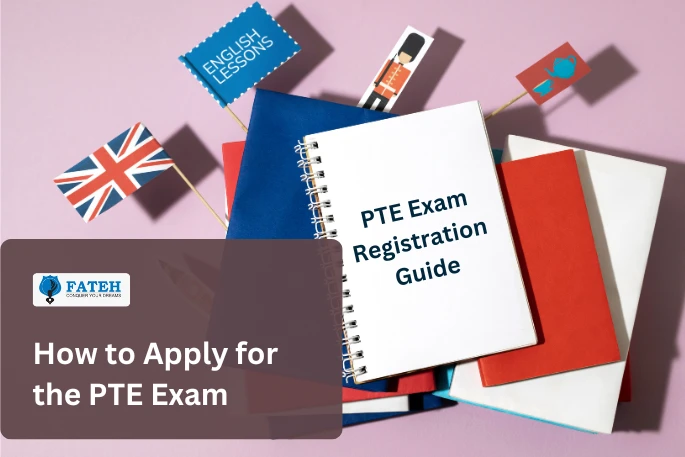Introduction
The Pearson Test of English (PTE) Academic is a go-to for students and professionals looking to study, work or move abroad. Accepted by universities, employers and governments worldwide, it tests your English skills – speaking, writing, reading and listening – in a clear, objective way. The fully digital format means no surprises, with fast results that fit even tight deadlines for visas or course applications.
Knowing how to apply for PTE exam is key to bagging your ideal test slot and avoiding last-minute stress. The process is simple but needs focus: set up a Pearson account, pick your nearest test centre and finish payment smoothly. We’ll walk you through each step, sharing handy pointers to make registration hassle-free.
But first, what makes PTE Academic stand out? Its reliability and fairness have made it a top choice for proving English skills – let’s see why.
Understanding the PTE Academic Exam
The PTE Academic exam is a computer-based English language proficiency test designed to assess the readiness of non-native speakers for academic environments. Accepted by thousands of universities, colleges, and governments worldwide, it has become a preferred choice for those seeking to study, work, or migrate to English-speaking countries. The exam stands out for its impartial scoring system, as all responses are evaluated by automated software, reducing human bias and ensuring consistency.
The structure of the PTE Academic is divided into three main sections: Speaking & Writing, Reading and Listening. The Speaking & Writing section, lasting between 54 and 67 minutes, tests a wide range of skills from reading aloud to essay writing. The Reading section, which takes about 29 to 30 minutes, includes tasks such as multiple choice, fill-in-the-blanks and paragraph reordering. The Listening section, lasting approximately 30 to 43 minutes, evaluates the ability to comprehend spoken English in academic contexts. Altogether, the exam features 20 distinct question types, each reflecting real-life academic scenarios and language use.
What sets the PTE Academic apart is its focus on integrated skills and real-world communication. The test not only measures grammar, vocabulary and pronunciation, but also the ability to synthesise information, participate in discussions and interpret academic texts. Results are typically available within two working days and the scores remain valid for two years. Candidates may retake the exam as many times as needed, with only a five-day gap between attempts.
Understanding the exam’s format and significance is the first step towards a successful application. However, before you learn how to apply for PTE exam, it’s important to ensure you meet the eligibility criteria set by Pearson and the institutions you’re targeting.
Next, let’s look at who can apply for the PTE Academic and what requirements you need to keep in mind before starting your registration.
Eligibility Criteria for PTE Academic
Before you begin the process of how to apply for PTE exam, it is essential to ensure you meet the eligibility requirements set by Pearson. These criteria are straightforward but non-negotiable and overlooking any detail could lead to complications on test day.
Age Requirements
- Minimum Age: You must be at least 16 years old to take the PTE Academic exam.
- Parental Consent: If you are under 18, a signed parental consent form is mandatory. This form must be submitted to Pearson before your test date.
- No Upper Age Limit: There is no maximum age restriction, making the exam suitable for both young students and mature professionals.
Educational Background
- No Academic Prerequisites: Pearson does not require any specific educational qualifications. Whether you are a recent school-leaver or a working professional, you are eligible to register.
- Institutional Requirements: While Pearson’s criteria are broad, individual universities or immigration authorities may have their own academic prerequisites. It is advisable to check these before starting your registration.
Identification Documents
- Accepted ID: A valid, original, and non-expired passport is the only acceptable identification at the PTE test centre.
- No Alternatives: Photocopies, scanned copies, or any other forms of ID will not be accepted. Candidates without the correct ID will be denied entry to the exam.
Nationality and Number of Attempts
- Open to All Nationalities: There are no nationality restrictions; anyone needing to demonstrate English proficiency for academic, professional, or migration purposes can apply.
- Retake Policy: There is no limit on the number of attempts. However, you must wait for your current test results before booking another slot.
Make sure you check these requirements before learning how to apply for PTE exam – missing even a small detail could set you back.
Once you’ve checked you’re eligible, the next step is simple: get to know the PTE Academic structure. Understanding the test format means no surprises on the day—just confidence and better prep.
Structure of the PTE Academic Exam
The PTE Academic exam is structured to assess a wide range of English language skills through a carefully designed, computer-based format. The exam is divided into three main sections: Speaking & Writing, Reading and Listening, each with its own unique set of tasks and time allocations.
Speaking & Writing (54–67 minutes)
This combined section evaluates your ability to communicate clearly and accurately in both spoken and written English. It includes tasks such as Personal Introduction, Read Aloud, Repeat Sentence, Describe Image, Retell Lecture, Answer Short Question, Summarise Written Text and Write Essay. Each task is timed, with the overall section lasting up to 67 minutes. The variety of question types, from reading aloud to essay writing, ensures a comprehensive assessment of your communication skills.
Reading (29–30 minutes)
In this section, you will encounter tasks like Fill in the Blanks, Multiple Choice (both single and multiple answers) and Re-order Paragraphs. The focus is on your ability to comprehend and interpret written English in academic contexts. The tasks are designed to mirror the types of reading you would encounter in a university setting, testing both speed and accuracy.
Listening (30–43 minutes)
The Listening section challenges your ability to understand spoken English through a range of tasks, including Summarise Spoken Text, Multiple Choice, Fill in the Blanks, Highlight Correct Summary, Select Missing Word, Highlight Incorrect Word and Write from Dictation. Audio clips are played only once, so attentive listening is crucial. This section assesses not just comprehension, but also your ability to extract key information and respond appropriately.
Each part of the PTE Academic is designed to reflect real-life academic scenarios, making it a relevant and practical choice for those preparing for study or work abroad.
With a clear understanding of the exam structure, you are now ready to explore how to apply for PTE exam. While the registration process is simple, being aware of the key details can help you navigate it seamlessly—ensuring everything runs smoothly from registration right through to test day.
Step-by-Step Guide to PTE Academic Registration
Registering for the PTE Academic exam is a straightforward online process, but knowing each step clearly can save you time and prevent errors. Here’s a detailed guide on how to apply for PTE exam smoothly.
Step 1: Create a Pearson Account
Visit the official Pearson PTE website and sign up by providing your personal details, including your full name as it appears on your passport, date of birth, email address and contact number. After registration, you will receive a confirmation email to verify your account.
Step 2: Choose Your Test Location and Date
Once logged in, select your country and city to find available test centres nearby. The system will show all available dates and times. It’s wise to book early, especially during peak seasons, to secure your preferred slot.
Step 3: Complete Your Profile
Fill in your profile with accurate identification details. Remember, the ID you enter must match the ID you bring on test day, usually a valid passport. Any discrepancy can lead to denial of entry at the test centre.
Step 4: Review and Confirm Booking
Carefully check all your details, including test centre, date, time and personal information. Make sure everything is correct before proceeding.
Step 5: Payment
Proceed to the payment gateway where you can pay using credit or debit cards, net banking or digital wallets, depending on your region. The payment process is secure and once completed, you will receive a confirmation email with your test details.
Alternative Registration Methods
While online registration is the most common, some countries also offer phone registration or in-person booking at test centres. Check the official Pearson website for availability in your region.
Completing these steps correctly ensures your registration is successful and you can focus on preparing for the exam.
With your registration done, it’s helpful to be aware of some important tips that can make the process even smoother and help avoid common mistakes.
Important Tips for PTE Exam Registration
1. Double-Check Your Details
When registering, ensure your name, date of birth and other details are an exact match with your passport. Even a minor spelling difference can prevent you from sitting the exam.
2. Book Early for Flexibility
Test centres in major cities can fill up months in advance, especially around university admission deadlines. Booking your slot well ahead gives you more options for dates and locations.
3. Passport Validity Matters
Your passport must be valid on the day of your exam. If your passport is close to expiring, renew it before you start the process of how to apply for PTE exam.
4. Use a Secure Internet Connection
Register from a stable, secure network to avoid payment glitches or incomplete submissions. Unstable connections have led to failed bookings for many candidates.
5. Save All Confirmation Emails
After registering, keep your confirmation email and any payment receipts in a dedicated folder. These documents are essential if you need to reschedule or clarify any issues with Pearson.
6. Special Requirements
If you need extra time or specific accommodations, reach out to Pearson at least a few weeks before your intended test date. Supporting documents are usually required and processing can take time.
7. Stick to Official Channels
Always register via the official Pearson PTE website. Third-party sites may not be up to date or secure, and errors can be hard to resolve.
With these insights in hand, you’ll breeze through the PTE exam application process—sidestepping typical mistakes while securing your test date with confidence.
Conclusion
In conclusion, understanding how to apply for PTE exam is the first step towards achieving your academic or professional goals abroad. The PTE Academic offers a reliable and efficient way to demonstrate your English proficiency, with a clear registration process and well-structured exam format.
At Fateh Education, we are committed to guiding you through every stage—from registration to preparation—ensuring you approach the exam with confidence and clarity. Reach out to us today to get personalised support tailored to your needs and take the next step in your study abroad journey with ease. Your success in the PTE exam starts with the right guidance!
Frequently Asked Questions (FAQs)
Yes, you can reschedule your PTE Academic exam through your myPTE account. If you reschedule more than 14 days before the test, there is no fee. Between 7 and 13 days prior, a 50% fee applies. Rescheduling is not allowed within 7 days unless for medical emergencies with valid documentation. Always confirm your new test details after rescheduling.
The PTE Academic exam fee in India is approximately ₹18,000. Late bookings within 48 hours of the test incur extra charges. Rescheduling 7–13 days before the exam costs 50% of the fee; no rescheduling is allowed within 7 days. Additional fees apply for sending extra score reports or requesting a rescore, which costs around $125 but is refunded if your score changes.
Prepare using official Pearson materials, sample questions and full-length practice tests to get familiar with the format and timing. Identify and work on weaker areas, use reputable books or online courses, and consider coaching if needed. Regular practice under timed conditions and joining study groups can boost confidence and improve performance.
Arrive 30 minutes early with your valid passport. After check-in and security screening, you’ll be seated at a computer to complete Speaking & Writing, Reading and Listening sections in one sitting. Follow test centre rules carefully. Results are usually available within two working days via email notification.


